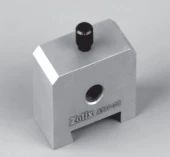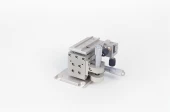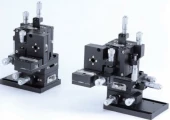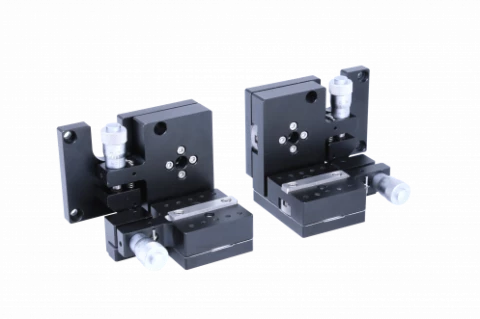Description
The UFP Series represents a line of high-sensitivity fiber optic alignment stages, distinguished by their ability to perform both coarse and fine adjustments. With a sensitivity that is exceptionally better than 0.5µm and a rotation stage sensitivity surpassing 23.4", these stages stand out in their category. Their remarkable stability and precision make them ideally suited for tasks that demand meticulous fiber alignment.
UFP series High Sensitivity Fiber Optic Alignment Stages
Specifications
| Hole Diameter: | 1000 um |
|---|---|
| Angle: | 0.01 – 3 deg |
| Structure Type: | Translation Stage |
| Table Sizes (mm): | 60×60 (UFP1A, UFP1C-L, UFP1C-R, UFP2T-L, UFP2T-R) |45×45 (UFP1B) |
| Table Thickness (mm): | 20 (UFP1A), 25 (UFP1B), 30 (UFP1C-L, UFP1C-R) |
| Actuators: | Micrometer |
| Static Parallelism (µm): | ≤60 |
| Motion Parallelism (µm): | ≤10 |
| Motion Straightness (µm): | ≤3 |
Features
Dual Adjustment Mechanisms: The linear stage offers both coarse and fine adjustments, providing versatility in alignment with a sensitivity superior to 0.5µm for fine adjustments.
High Sensitivity Rotation Stage: The rotation stage features a sensitivity that surpasses 23.4 arcseconds, ensuring precision in rotational alignment.
High Stability: Engineered for stability, these stages ensure consistent and reliable performance across applications.
Variety of Models: With models varying in table size, thickness, and type of bearings, users have a range of options to suit different requirements.
Crossed-Roller Bearings: Certain models are equipped with crossed-roller bearings, known for their precision and reliability, ensuring smooth motion and enhanced stability.
Micrometer Actuators: Equipped with micrometer actuators for precise adjustments and control.
Load Capacity: With a load capacity ranging from 1.5 to 5 Kg, these stages are versatile for various applications.
Static and Motion Parallelism: Featuring low static and motion parallelism, these stages maintain alignment and uniformity in movement.
Motion Straightness: The stages boast a motion straightness of less than or equal to 3µm, indicative of their precision in linear movement.
Applications
Fiber Optic Alignment: With their high sensitivity and stability, these stages are ideal for aligning fiber optics where precision is paramount.
Optical Experimentation: The versatility and range of models make them suitable for a variety of optical experiments requiring accurate positioning and alignment.
Microscopy: The precision and stability offered by these stages make them a good fit for microscopy applications where fine adjustments are essential.
Research and Development: In R&D settings, where precision and reliability are key, these stages can be integral in developing new technologies and conducting experiments.
Photonics and Laser Applications: The high sensitivity and stability make these stages suitable for applications in photonics and laser technology, where precise alignment is crucial.
Semiconductor Manufacturing: The need for precision and stability in semiconductor manufacturing can be met by the UFP series stages.
Frequently Asked Questions
What is the sensitivity of the UFP series high sensitivity fiber optic alignment stages?
What is the stability of the UFP series high sensitivity fiber optic alignment stages?
What are the available models in the UFP series high sensitivity fiber optic alignment stages?
What are the dimensions of the UFP1A model?
What is the weight of the UFP1B model?
Similar Products




Your inquiry has been received.
Create an account by adding a password
Why create an account?
- Auto-complete inquiry forms
- View and manage all your past messages
- Save products to your favorites
- Close your account anytime — no hassle
